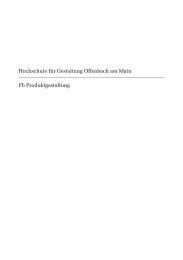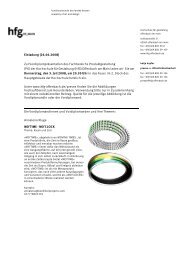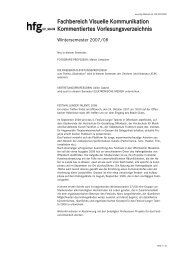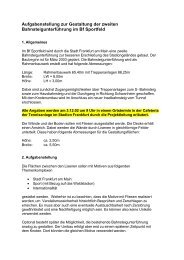Objets et Communication MEI - Hochschule für Gestaltung ...
Objets et Communication MEI - Hochschule für Gestaltung ...
Objets et Communication MEI - Hochschule für Gestaltung ...
You also want an ePaper? Increase the reach of your titles
YUMPU automatically turns print PDFs into web optimized ePapers that Google loves.
OBJETS &<br />
COMMUNICATION<br />
Sous la direction de Bernard Darras<br />
& de Sarah Belkhamsa<br />
5.5 Designers<br />
Nathalie Audigier<br />
Sarah Belkhamsa<br />
Anne Beyaert-Geslin<br />
Bernhard Bürdek<br />
Jacob Buur<br />
Bernard Darras<br />
Michela Deni<br />
Jean-Philippe Dupuy<br />
Jean Fis<strong>et</strong>te<br />
Jacques Fontanille<br />
Christophe Genin<br />
Xotchitl Arias Gonzales<br />
Jérôme Guibourgé<br />
Jan Hadlaw<br />
Trine Heinemann<br />
Jung-A Hue<br />
Jung-Hae Kim<br />
B<strong>et</strong>ti Marenko<br />
Gavin Melles<br />
Johann van der Merwe<br />
Robb Mitchell<br />
Marc Monjou<br />
Nanta Novello Paglianti<br />
Andrzej Piotrowski<br />
Giampaolo Proni<br />
Keith Russell<br />
David Tucker<br />
Susann Vihma<br />
Alessandro Zinna
Sous la direction de<br />
Bernard Darras & Sarah Belkhamsa<br />
<strong>Obj<strong>et</strong>s</strong> & cOmmunicatiOn<br />
<strong>MEI</strong> N°30-31<br />
L’Harmattan
mei « médiation & infor ma tion ».<br />
Revue internationale de communi cation<br />
Une revUe-livre. — Créée en 1993 par Bernard Darras (Université de Paris 1) <strong>et</strong> Marie Thonon (Université<br />
de Paris VIII), <strong>MEI</strong> « Médiation Et Information » est une revue thématique biannuelle présentée<br />
sous forme d’ouvrage de référence. La responsabilité éditoriale <strong>et</strong> scientifique de chaque numéro<br />
thématique est confiée à une Direction invitée, qui coordonne les travaux d’une dizaine de chercheurs.<br />
Son travail est soutenu par le Comité de rédaction <strong>et</strong> le Comité de lecture. Une contribution annuelle du<br />
Centre National du Livre (CNL) perm<strong>et</strong> un fonctionnement souple <strong>et</strong> indépendant.<br />
Une revUe-livre de référence. — <strong>MEI</strong> est l’une des revues de référence spécialisées en Sciences de l’information<br />
<strong>et</strong> de la communication, reconnue comme “qualifiante” par l’Agence d’évaluation de la recherche<br />
<strong>et</strong> de l’enseignement supérieur (aéres). Elle est de plus certifiée par le Conseil national des universités<br />
(CNU). Le dispositif d’évaluation en double aveugle garantit le niveau scientifique des contributions.<br />
Une revUe-livre internationale. — <strong>MEI</strong> « Médiation <strong>et</strong> information » est une publication internationale<br />
destinée à promouvoir <strong>et</strong> diffuser la recherche en médiation, communication <strong>et</strong> sciences de l’information.<br />
Onze universités françaises, belges, suisses ou canadiennes sont représentées dans le Comité de<br />
rédaction <strong>et</strong> le Comité scientifique.<br />
Un dispositif éditorial thématiqUe. — Autour d’un thème ou d’une problématique, chaque numéro<br />
de <strong>MEI</strong> « Médiation <strong>et</strong> information » est composé de trois parties. La première est consacrée à un entr<strong>et</strong>ien<br />
avec les acteurs du domaine abordé. La seconde est composée d’une dizaine d’articles de recherche.<br />
La troisième présente la synthèse des travaux de jeunes chercheurs.<br />
Monnaie Kushana, représentation de Miiro<br />
Source : Hinnels, J., 1973. Persian Mythology. Londres : Hamlyn Publishing Group Ltd.<br />
Médiation <strong>et</strong> infor ma tion, tel est le titre de notre<br />
pu bli cation. Un titre dont l’abréviation mei correspond<br />
aux trois l<strong>et</strong>tres de l’une des plus riches racines<br />
des langues indoeuro péennes. Une racine si<br />
riche qu’elle ne pouvait être que di vine. C’est ainsi<br />
que le dieu védique Mitra en fut le pre mier dépositaire.<br />
Meitra témoigne de l’alliance conclue entre<br />
les hommes <strong>et</strong> les dieux. Son nom évoque l’alliance<br />
fondée sur un contrat. Il est l’ami des hommes <strong>et</strong><br />
de façon plus gé né rale de toute la création. Dans<br />
l’ordre cos mique, il préside au jour en gardant la<br />
lumière. Il devient Mithra le garant, divin <strong>et</strong> solaire<br />
pour les Perses <strong>et</strong> il engendre le mithraïsme<br />
dans le monde grec <strong>et</strong> romain.<br />
R<strong>et</strong>enir un tel titre pour une revue de communi<br />
cation <strong>et</strong> de médiation était inévitable. Dans<br />
l’univers du verbe, le riche espace séman tique de<br />
mei est abondamment exploité par de nom breuses<br />
langues fondatrices. En védique, mitra signifie<br />
“ami ou contrat”. En grec, ameibein signi fie<br />
“échanger”, ce qui donne naissance à amoibaios<br />
“qui change <strong>et</strong> se ré pond”. En latin, quatre grandes<br />
familles seront déclinées : mu tare “mu ter, changer,<br />
mutuel…”, munus “qui appartient à plu sieurs personnes”,<br />
mais aussi “cadeau” <strong>et</strong> “com muniquer”,<br />
meare “pas ser, circu ler, permis sion, perméable,<br />
tra verser…” <strong>et</strong> enfin migrare “chan ger de place”.<br />
© 2009, auteurs & Éditions de l’Harmattan.<br />
7, rue de l’Écolepolytechnique. 75005 Paris.<br />
Site Web : http://www.librairieharmattan.com<br />
Courriel : diffusion.harmattan@wanadoo.fr <strong>et</strong> harmattan1@wanadoo.fr<br />
ISBN : 9782296117075 EAN : 9782296117075
Direction de publication<br />
Bernard Darras<br />
Rédaction en chef<br />
Marie Thonon<br />
Comité scientifique<br />
Jean Fis<strong>et</strong>te (UQAM, Québec)<br />
Pierre FresnaultDeruelle (Paris I)<br />
Geneviève Jacquinot (Paris VIII)<br />
Marc Jimenez (Paris I)<br />
Gérard Loiseau (CNRS, Toulouse)<br />
Armand Mattelart (Paris VIII)<br />
J.P. Meunier (LouvainlaNeuve)<br />
Bernard Miège (Grenoble)<br />
Jean Mouchon (Paris X)<br />
Daniel Peraya (Genève)<br />
Comité de lecture<br />
Jan Ba<strong>et</strong>ens, Katholieke Universiteit Leuven<br />
Brigitte Borja de Mozotta, Université Paris X<br />
Karen BrunelLafargue, Université Paris I<br />
Dominique Chateau, Université Paris I<br />
Nicole EveraertDesmedt, Faculté Universitaire Saint<br />
Louis, Bruxelles<br />
Silvia FilippiniFantoni, Université Paris I<br />
Alain Findeli, Université de Nîmes<br />
Pierre FresnaultDeruelle, Université Paris I<br />
Pascal Froissart, Université Paris VIII<br />
JeanPierre Meunier, Université de LouvainlaNeuve<br />
Marie Thonon, Université Paris VIII<br />
Philippe Verhaegen, Université de LouvainlaNeuve<br />
Édition & révision<br />
Pascal Froissart<br />
Secrétariat<br />
Gisèle Boulzagu<strong>et</strong><br />
Comité de rédaction<br />
Dominique Chateau (Paris I)<br />
Bernard Darras (Paris I)<br />
Pascal Froissart (Paris VIII)<br />
Gérard Leblanc (École nationale supérieure « LouisLumière<br />
»)<br />
Pierre Moeglin (Paris XIII)<br />
Alain Mons (Bordeaux III)<br />
Jean Mott<strong>et</strong> (Paris I)<br />
Marie Thonon (Paris VIII)<br />
Patricio Tupper (Paris VIII)<br />
Guy Lochard (Paris III)<br />
Correspondants<br />
Robert Boure (Toulouse III)<br />
Alain Payeur (Université du Littoral)<br />
Serge Proulx (UQAM, Québec)<br />
MarieClaude V<strong>et</strong>trainoSoulard (Paris VII)<br />
Les articles n’engagent que leurs auteurs ; tous droits réservés.<br />
Les auteurs des articles sont seuls responsables de tous les droits relatifs<br />
aux images qu’ils présentent.<br />
Toute reproduction intégrale ou partielle, faite sans le consentement<br />
de son auteur ou de ses ayants droits, est illicite.<br />
Éditions Op. Cit. — Revue <strong>MEI</strong> « Médiation <strong>et</strong> information »<br />
6, rue des Rosiers. 75004 Paris (France)<br />
Tél. & fax : +33 (0) 1 49 40 66 57<br />
Courriel : revuemei@laposte.n<strong>et</strong><br />
Revue publiée avec le concours du Centre national du livre
Nous remercions tout particulièrement<br />
Rodrigo Angulo, Danay Catalan Alfaro, Fabien Gavin<strong>et</strong> <strong>et</strong> Benjamin Leleu<br />
qui ont assuré le design <strong>et</strong> la mise en page de ce numéro de <strong>MEI</strong>.
Éditorial<br />
Les obj<strong>et</strong>s communiquentils ?<br />
par Bernard Darras & Sarah Belkhamsa--------------------------------------------------------------------------------------7<br />
entr<strong>et</strong>ien<br />
Design <strong>et</strong> communication.<br />
Questions de Bernard Darras & Sarah Belkhamsa à 5.5 ---------------------------------------------------------------9<br />
Dossier<br />
Objects : In b<strong>et</strong>ween language and meaning<br />
Bernhard E. Bürdek --------------------------------------------------------------------------------------------------------41<br />
Les obj<strong>et</strong>s communiquants : des corps, entre texte <strong>et</strong> pratiques<br />
Jacques Fontanille & Xochitl Arias Gonzalez -------------------------------------------------------------------53<br />
À quel point en sommesnous avec la sémiotique de l’obj<strong>et</strong> ?<br />
Alessandro Zinna ----------------------------------------------------------------------------------------------------------69<br />
L’intervention sémiotique dans le proj<strong>et</strong> : du concept à l’obj<strong>et</strong><br />
Michela Deni ------------------------------------------------------------------------------------------------------------------87<br />
Formes de table, formes de vie. Réflexions sémiotiques pour vivre ensemble<br />
Anne Beyaert-Geslin ------------------------------------------------------------------------------------------------------99<br />
Obj<strong>et</strong> <strong>et</strong> préfiguration. L’exemple du menu de restaurant<br />
Jean-Philippe Dupuy ------------------------------------------------------------------------------------------------111<br />
Le label AB (agriculture biologique) : interactions sémiotiques entre l’individu <strong>et</strong> l’environnement<br />
Nanta Novello Paglianti -------------------------------------------------------------------------------------------------123<br />
Sémiotique <strong>et</strong> design produit : un obj<strong>et</strong> commun ?<br />
Marc Monjou -----------------------------------------------------------------------------------------------------------------133<br />
L’obj<strong>et</strong> <strong>et</strong> le cycle des habitudes <strong>et</strong> des changements d’habitudes. Approche sémiotique<br />
Sarah Belkhamsa & Bernard Darras ------------------------------------------------------------------------------147<br />
Modélisation dynamique de la communication de l’obj<strong>et</strong>. Approche systémique <strong>et</strong> sémiotique<br />
Bernard Darras & Sarah Belkhamsa ------------------------------------------------------------------------------161<br />
The function of nonfunctional objects. Semiotics of functionalism<br />
Giampaolo Proni ---------------------------------- ------------------------------------------------------------------------185<br />
On design semiotics<br />
Susann Vihma --------------------------------------------------------------------------------------------------------------197<br />
Les signes pour se guider dans l’univers. La boussole, l’astrolabe, l’arbalète, le loch ... <strong>et</strong> le GPS.<br />
Jean Fis<strong>et</strong>te ------------------------------------------------------------------------------------------------------------------209<br />
Who is in the driver’s seat ? The car/driver interface<br />
David L. Tucker -------------------------------------------------------------------------------------------------------------225<br />
Objectrelics and their effects : for a neoanimist paradigm<br />
B<strong>et</strong>ti Marenko --------------------------------------------------------------------------------------------------------------239
Architecture and the shaping of thought<br />
Andrzej Piotrowski -------------------------------------------------------------------------------------------------------255<br />
Le circuit de la culture <strong>et</strong> le designer : nouvel intermédiaire culturel ou technicien ?<br />
Gavin Melles ----------------------------------------------------------------------------------------------------------------269<br />
The secr<strong>et</strong> lives of ANTs<br />
Johann van der Merwe -------------------------------------------------------------------------------------------------279<br />
Coconstructing meaning with materials in innovation workshops<br />
Trine Heinemann, Robb Mitchell & Jacob Buur ------------------------------------------------------------289<br />
<strong>Obj<strong>et</strong>s</strong>, culture, valeurs <strong>et</strong> marque<br />
Jérôme Guibourgé --------------------------------------------------------------------------------------------------------305<br />
La patrimonialisation comme arme concurrentielle<br />
Nathalie Audigier ----------------------------------------------------------------------------------------------------------315<br />
The design contest : the function, form, and meaning of the Bell telephone, 19201939<br />
Jan Hadlaw ------------------------------------------------------------------------------------------------------------------329<br />
Le gaucher contrariant : critique de l’obj<strong>et</strong> polarisé<br />
Christophe Genin ---------------------------------------------------------------------------------------------------------341<br />
L’obj<strong>et</strong> symbolique sacré du bouddhisme <strong>et</strong> son double mode de communication dimensionnelle : la<br />
pagode <strong>et</strong> le mandala<br />
Jung-Hae Kim ---------------------------------------------------------------------------------------------------------------353<br />
On the shine of things and the uses of Gleaming<br />
Keith Russell------------------------------------------------------------------------------------------------------------------363<br />
La table qui désire la communication. Ponge and the object<br />
Jung-A Hue -------------------------------------------------------------------------------------------------------------------373<br />
Conditions de publication ------------------------------------------------------------------------------------------------385<br />
Numéros déjà parus -------------------------------------------------------------------------------------------------------386<br />
Bull<strong>et</strong>ins d’abonnement --------------------------------------------------------------------------------------------------392
Objects : in b<strong>et</strong>ween language<br />
and meaning<br />
Prof. Bernhard e. BÜrDek 1<br />
Product Design is constantly moving from an Applied Art towards a scientific foundation.<br />
During the 20th century, the main focus was on a functional approach, but the<br />
postmodern movement in the 1980’s and the linguistic turn shifted the priority in design<br />
from function to meaning (Bürdek 2005)<br />
Since the 1970´s, two fields of research have become important: product language and<br />
product semantics. Both are based on semiotics and communication theory. What are<br />
the similarities and what are the differences? And how can objects be described as<br />
language and meaning?<br />
Keywords : design, disciplinary design theory, language, linguistic turn, meaning,<br />
product language, product semantics, semiotics<br />
Le design produit tend en permanence à passer du domaine des arts appliqué à un<br />
fondement scientifique. Au XX e siècle, l’accent était mis sur une approche fonction-<br />
nelle, mais le mouvement postmoderne des années 1980 <strong>et</strong> le linguistic turn (tournant<br />
linguistique) a déplacé la priorité du design de la fonction au sens (Bürdek 2005).<br />
Depuis les années 1970, deux domaines de recherche ont gagné en importance : le<br />
lan- gage <strong>et</strong> la sémantique du produit. Tous deux sont fondés sur la sémiotique <strong>et</strong> la<br />
théorie de la communication. Quelles en sont les similarités <strong>et</strong> quelles en sont les<br />
différences ? Comment décrire les obj<strong>et</strong>s comme porteurs de langage <strong>et</strong> de sens ?<br />
Mots-clés : design, théorie du discipline design, langage, linguistic turn, sens,<br />
langage du produit, sémantique du produit, sémiotique<br />
1 Prof. Bernhard E. BüRDEK born in 1947, was one of last students at the Ulm Design School. Since<br />
1971 he is working as a designer, teacher, author and consultant. At the Academy of Art, Design and<br />
Media at Offenbach am Main he teaches Design Theory, Design M<strong>et</strong>hodology, Product Language and<br />
Strategic Design. He was guest lecturing in Brasil, Mexico, Roumania and Taiwan and is the author of<br />
numerous publications. In 1990 he founded Vision & Gestalt, an office for design and communication.<br />
41
OBJETS & COMMUNICATION <strong>MEI</strong> 30-31<br />
Leonardo da Vinci, the Italian painter, sculptor, architect, engineer, art scientist<br />
<strong>et</strong>c., was the first designer in the world. He believed knowledge was based<br />
on visual perception and developed a compatible connection b<strong>et</strong>ween art and<br />
science, a topic still relevant today. Therefore, with Leonardo da Vinci, the idea<br />
that designers are inventors of technical systems began its long career, and the<br />
European tradition of a functional approach in design was chiefly based on these<br />
ideas, principles and projects.<br />
These roots constitute the basis of German Bauhaus Design (in Weimar, Dessau<br />
and Berlin), as well as that of the legendary <strong>Hochschule</strong> <strong>für</strong> <strong>Gestaltung</strong> at Ulm<br />
(Ulm Design School) from 1955-1968. German Design’s functional heritage was<br />
grounded there, and the tradition of a functional approach in many different<br />
European countries (such as Scandinavia, UK, the N<strong>et</strong>herlands, <strong>et</strong>c.) was born<br />
of this notion.<br />
Beyond this, it is important to know that the first steps toward a semiotic-based<br />
“theory of design” were undertaken in the early 1960´s at the Ulm Design School<br />
by Max Bense, Tomás Maldonado, Gui Bonsiepe and Klaus Krippendorff. Maldonado<br />
(1961) published an equivalent to a dictionary of semiotics, and Gui<br />
Bonsiepe (1963) introduced the importance of semiotics in design: the shared<br />
structure of the world of products and the world of signs suggests that the communicative<br />
aspects would represent the most important component of Industrial<br />
Design theory.<br />
In this context, it is necessary to discuss some philosophical changes in the 20 th<br />
century. The so-called linguistic turn was a very radical adjustment: the subjectobject<br />
debate shifted away from philosophy to concentrate on the new premise<br />
that the understanding of world (its problems and even its products) is mainly<br />
achieved through language. It is therefore important to research language itself,<br />
to discover its principles and transform this knowledge into design theory.<br />
It is necessary to mention some of the most important forerunners and their<br />
contributions, which are – in my opinion – still pertinent today, because they<br />
form the theor<strong>et</strong>ical pillars upon which rests the design theory debate of the 20 th<br />
century.<br />
Roland Barthes (1985) was one of the early literary critics who wrote, for example,<br />
that fashion has two meanings: it is both of practical utility and a rh<strong>et</strong>orical statement.<br />
When the legendary Citröen DS came onto the mark<strong>et</strong> in 1955, he remarked<br />
(Barthes 1981) that this car was comparable to the gothic cathedrals: a revolution<br />
in the form of an automobile. Also, Barthes was a co-founder of structuralism,<br />
which became the most important movement of the 1960´s.<br />
42
OBJECTS : IN BETwEEN lANgUAgE ANd MEANINg<br />
In 1968, Jean Baudrillard published “Le système des obj<strong>et</strong>s” and although he does<br />
not directly tackle the problems of design, it has gone on to become one of the<br />
most influential books in this field. To him, structural design is mainly a system<br />
of meaning. All products move from a technical system into a cultural system,<br />
implying that they have both (objective) denotations and (semantic) connotations.<br />
Baudrillard said, that as opposed to language, the system of objects is a constant<br />
interference b<strong>et</strong>ween a practical and a technical system. He further demonstrated<br />
that, based on semiotic principles, a close similarity exists b<strong>et</strong>ween the spoken<br />
language and the language of things.<br />
Also in 1968, the Italian Umberto Eco published his “La struttura Assente” which<br />
became the second pillar for modern design theory. He posits that communication<br />
is based on codes, agreed upon in soci<strong>et</strong>y. Understanding the codes and<br />
their meanings is necessary, as they are d<strong>et</strong>erminant in communication. Eco also<br />
wrote that semiotics is a general m<strong>et</strong>hod by which all types of cultural forms of<br />
interactions can be interpr<strong>et</strong>ed. In his famous chapter about “Architecture and<br />
<strong>Communication</strong>” Eco points out, that his conclusions are similar for architecture,<br />
design and city planning. The general use of architecture (or products) is not only<br />
functional but also cultural, implying that the use also d<strong>et</strong>ermines the meaning<br />
On this basis, Eco distinguishes b<strong>et</strong>ween the primary and the secondary functions<br />
of buildings. He then goes on to discuss the primary function, which is<br />
denoted, and the secondary function, which is connoted. This is not a value judgement,<br />
but seeks only to demonstrate the two faces of a coin – or b<strong>et</strong>ter, of a product.<br />
For Eco, the entire world is constructed of signs, and a culture’s condition<br />
can be read from its signs.<br />
In the 1970´s we - at the Offenbach Academy of Art, Design & Media - began<br />
discussing a new approach for design theory and design practice (Bürdek 1991).<br />
We had in mind the history of product culture and decided not to focus on natural<br />
science (like the big technical universities), but on humanities. In the beginning,<br />
we needed to address some questions with regards to our scientific approach. A<br />
most basic way of de veloping a discipline is to d<strong>et</strong>ermine the targ<strong>et</strong>s, the objects<br />
and the m<strong>et</strong>hods:<br />
With design, the targ<strong>et</strong> is to develop an independent discipline<br />
with own principles, rules, lan guage, <strong>et</strong>c.<br />
The object of design is the relationship b<strong>et</strong>ween a user and a<br />
product, as expressed via language and semiotics<br />
43
OBJETS & COMMUNICATION <strong>MEI</strong> 30-31<br />
The m<strong>et</strong>hods for this approach stem from the Humanities –<br />
not from natural sciences, as it is the case in engineering, <strong>et</strong>c.<br />
Design is a form of communication, it transports meaning<br />
from the objects to the users and from the user into soci<strong>et</strong>y.<br />
I remain convinced of the necessity to develop a disciplinary kernel of design<br />
mainly based on communication. This goes along with Nigel Cross’ observations<br />
(2001), when he described three paradigmatic changes in design’s development<br />
in the 20 th century: in the 1920s, scientific findings were integrated into design<br />
training for the first time (at the German Bauhaus); the 1960´s were the heyday<br />
of design m<strong>et</strong>hodology (in England, the USA and the Ulm Design School) but<br />
this era also marked the beginning of scientific design; today, in the 2000´s the<br />
emphasis is on enhancing design’s profile as an independent discipline. Furthermore,<br />
beyond all inter-, multi- or even trans-disciplinary approaches, without its<br />
own knowledge, design will be unable to exist in the world of science. In such<br />
a case, it has to move into the field of arts, which many designers are indeed<br />
doing today. Thus they are no longer expected to justify what they are doing<br />
scientifically.<br />
Language – or commutative action – was once designated by Jürgen Habermas<br />
(1985) as the “key to constructing theory”, b<strong>et</strong>ter allowing us to deal with the<br />
capricious structures of the life-world. Reality is imparted and explained through<br />
language, and this also holds true for design. A further analogy is significant<br />
here: language is not uniform; there are different languages and within them<br />
more dialects and figures of speech exist. Language is a multi-layered entity that<br />
can describe complicated and complex facts. At the same time, each language<br />
has rules of usage – in the terms of semiotics: syntax, pragmatic and semantic.<br />
It is from this theor<strong>et</strong>ical background that we began to develop, in the mid 1970´s,<br />
a so-called “theory of product language” dedicated to the communicative function<br />
of design. Based on the analysis of aesth<strong>et</strong>ic functions, the Czech linguist Jan<br />
Mukařovský (1970) proposed a model which became the basis for the Offenbach<br />
approach:<br />
44
OBJECTS : IN BETwEEN lANgUAgE ANd MEANINg<br />
Diagram 1: The product function model<br />
Although the importance of this model is still relevant, we must also consider that<br />
the arguments for the different types of functions are changing. Today, <strong>et</strong>hnological<br />
and anthropological research has largely influenced symbolic functions, as<br />
they represent the different cultural values in a globalized world (Hahn 2005).<br />
For example, the international automobile industry does a lot of research in of<br />
consumer behaviour, such as in Asia, as it represents a very important mark<strong>et</strong>.<br />
Ethnological research often starts at home: what are the different values of<br />
user groups, communities or even regional differences within a country. Design<br />
45
OBJETS & COMMUNICATION <strong>MEI</strong> 30-31<br />
concentrates not only on global mark<strong>et</strong>s but also on changing cultural values, the<br />
LOHAS (Lifestyles of Health and Sustainability), the priority shift towards new<br />
values, new consciousness, new needs, involving a new focus on man, slowing<br />
down, health, and durability. There is a very strong need for new products and<br />
new services (www.lohas.de).<br />
This only illustrates how product language must move towards a new representation<br />
of values and meaning. Today, the center of design research is to be found<br />
not just in the single product but also in the lifestyles of people as a whole.<br />
Looking to some other references, it is obvious that this approach of design theory<br />
– focused on language and meaning – dominates the international discourse.<br />
Based on their empirical studies in the 1970´s, Mihaly Csikszentmihalyi and<br />
Eugene Rochberg-Halton (1981) published “The Meaning of Things” in which<br />
they concentrated of individual forms of living and their meaning for the user.<br />
Both were familiar with the work of French anthropologist Claude Levi-Strauss<br />
and the aforementioned Roland Barthes. For them, things are not only practical<br />
objects but also units of information. From a semiotic perspective, which they<br />
also adopted, objects are signs within soci<strong>et</strong>ies and they constitute the frame of<br />
reference for our experiences. The fields of furniture design and everyday objects<br />
constitute an exciting area for such an analysis. It is obvious that everyday objects<br />
are loaded with so much semantic baggage that for the most part their only remaining<br />
function is to serve as orientation aids in a social context.<br />
The Austrian Helene Karmasin adopts a similar point of view . She associates<br />
aspects of psychology (cognitive and linguistic), sociology, cultural studies and<br />
communication sciences (semiotics) to produce a work that is both remarkable<br />
and highly original. When the first edition was published in 1993 it was obvious<br />
that semiotics – as a fundamental theory of communication – can be used widely<br />
for products and advertising campaigns. She wrote that when “products are messages,”<br />
then we may use them to communicate and thus by combining different<br />
products we may express and transfer meanings (e.g. in the everyday), which may<br />
be understood by all parts of soci<strong>et</strong>y. For example the IKEA’s “Billy” bookshelf is<br />
not only an excellent product for storing many books, but it is also a sign, indicative<br />
of the basic functional idea of furniture –to serve a purpose. As opposed to<br />
when the Italian designer Ettore Sottsass Jr. designed his “Carlton” bookshelf for<br />
the first Memphis collection in 1981, it was obvious that this product is primarily<br />
a semiotic system. One can, of course, store books in it, but it looks much b<strong>et</strong>ter<br />
left empty. The “Carlton” more closely resembles a living room sculpture than a<br />
piece of furniture, and its purpose as an object is therefore more semantic than<br />
functional. Promoted mainly in Italy in the beginning of the 1980´s, the “Carlton”<br />
46
OBJECTS : IN BETwEEN lANgUAgE ANd MEANINg<br />
became the most emblematic product in the transition from the modern to the<br />
post-modern movement.<br />
Diagram/picture 2: Ettore Sottsass Bookshelf Carlton<br />
That said, beyond such obvious examples of product design a strong theor<strong>et</strong>ical<br />
movement – mainly based on semiotic research – developed and was only partly<br />
recognised by the international design community.<br />
Helene Karmasin (1993, p. 190) placed emphasis on three most important aspects:<br />
-All objects in our culture transfer meaning – they are semantic.<br />
-The meaning is not the result of single products (this is more<br />
the symbolic aspect, like in the diagram of product language),<br />
but more that of classes of objects. Meaning results from the relationship<br />
b<strong>et</strong>ween of one element in the system and other objects.<br />
-Wh<strong>et</strong>her conscious or unconscious, this process is automatic,<br />
and organic to man’s social and cultural quality.<br />
47
OBJETS & COMMUNICATION <strong>MEI</strong> 30-31<br />
As demonstrated above – in the case of the LOHAS – product semantics is a way<br />
of understanding the meaning of objects in a soci<strong>et</strong>y.<br />
Susan Vihma (1995), a Finnish scientist at the UIAH (University of Art and Design<br />
Helsinki) published her dissertation on “Products as Representation” which<br />
went on to become a milestone in the product semantic and product language<br />
movement. She wrote “the representative function of design products has been studied<br />
very little because technical and ergonomic aspects have had priority in product<br />
development” (p.10), which was typical worldwide for design from its beginning<br />
until the 1980´s. She recognised that beyond traditional design history there is<br />
a cultural history (as written by Roland Barthes or Umberto Eco, for example),<br />
in which the authors refer to products as symbols and as language-like systems.<br />
She therefore cites Charles S. Peirce as her main reference. Vihma discusses “the<br />
constitution of the semiotic sign in the case of a design product and analysed its functions<br />
as a sign” (S.11). According to her, products are not only physical objects but<br />
also – or primarily – means of communication. Product language (in the sense<br />
of the Offenbach approach) is dedicated to the relationship b<strong>et</strong>ween the product<br />
and the user. Thus, product language – especially in the area of electronic products<br />
– must be able to make a product understandable without any user manual<br />
(Bürdek 2001).<br />
Beyond her important theor<strong>et</strong>ical discourse, Susann Vihma also analysed a lot of<br />
existing products and gave an excellent semantic or even symbolic interpr<strong>et</strong>ation<br />
of everyday objects, such as steam iron: their handling, their colours and their<br />
overall iconic sense in the communication at home and with the guests. Almost<br />
a decade later it became obvious that modern and extremely designed kitchens<br />
are not only for cooking, but they are much more symbolic tools representing the<br />
status of the owner, visualising his or her professional art of cooking (wh<strong>et</strong>her it<br />
is or not). Here it is obvious, that design has widely changed from “function to<br />
meaning” (Bürdek 2008).<br />
A very similar movement began in the USA in the 1970´s. Klaus Krippendorff,<br />
a former Ulm Design School student who finished his studies there in 1958<br />
with a thesis on semiotics. In the 1980´s he and Reinhard Butter (also a former<br />
Ulm Design School student, also teaching in the USA) led a special issue of the<br />
journal Innovation (published by the Industrial Designers Soci<strong>et</strong>y of America),<br />
entitled “The Semantics of Form”. Michael and Katherine McCoy taught at the<br />
renewed Cranbrook Academy near D<strong>et</strong>roit, Michigan (USA) from 1970 to 1995.<br />
They became most influencial in product semantics teaching. Michael McCoy<br />
(1996) compared the “linguistic turn”, which came into force in structuralism<br />
and poststructuralism, with examples of so-called post-modern architecture from<br />
the 1970s and 1980, as widely presented by Charles Jencks (1978) in his legendary<br />
work “The language of post-modern architecture”.<br />
48
OBJECTS : IN BETwEEN lANgUAgE ANd MEANINg<br />
Diagram 3: Klaus Krippendorff: Trajectory of artificiality<br />
The most fundamental book in this field is Klaus Krippendorff’s (2006) “The<br />
semantic turn”, because within he established product semantics based on communication<br />
theory. He developed a “Trajectory of Artificiality” in which he represents<br />
a compl<strong>et</strong>e system of knowledge: from the products to the discourses.<br />
Krippendorff’s model is a very comprehensive one and contains a special focus on<br />
human-centred design. He believes the user is more important than the product.<br />
His idea of “stakeholders” designates the intensive involvement of users in the<br />
process of development and design. As opposed to the product language movement<br />
(which concentrates more on the products), the product semantic model<br />
concentrates on the compl<strong>et</strong>e process of innovation.<br />
He starts with a very simple statement: “Design is making sense of things”. Krippendorff<br />
who teaches communication theory at the University of Pennsylvania<br />
(Philadelphia, PA) is strictly orientated towards linguistics when he wrote: “The<br />
semantic turn needs to take the role of language in the use of technology seriously. It is<br />
the use of language that distinguishes forms, materials, functions, and problems, and<br />
directs designers attention to what they are to do with them. It might appear obvious<br />
that artefacts do not exist without their makers, but colours are artefacts as well, being<br />
the product of the human perceptual apparatus. Without language one would have no<br />
inclination of what other fellow humans perceive”. (p.23) In d<strong>et</strong>ail, he underscores<br />
how important language is for design and its theory, when he wrote: language is<br />
a system of signs and symbols, language is a medium of individual expression,<br />
language as a medium of interpr<strong>et</strong>ation and others (p. 150-152).<br />
Krippendorff, who began his career, as mentioned above, as a trained designer,<br />
really developed a “practice-based Design Theory”: meaning he presents many<br />
products of the “real” world and dicusses them from a semantic point of view.<br />
49
OBJETS & COMMUNICATION <strong>MEI</strong> 30-31<br />
It is for this reason that I compl<strong>et</strong>ely agree with him when he contends that the<br />
“semantic turn” lead to a science of design. Numerous other approaches, such<br />
as art history or cultural sciences, contemplate the possibility of a “science about<br />
design” but none other call for the development as a “science of design”.<br />
Deyan Sudjic (2008), current Director of the Design Museum London (UK),<br />
put forward a profound report about “The Language of Things”. Although this<br />
publication is not a scientific one, it reflects on a high level and offers a number<br />
of actual product examples describing how product language became the leading<br />
philosophy in product planning, product development and product design. Sudjic<br />
reminds us, that “both Barthes and Baudrillard were strikingly uninterested in any<br />
discussion of the role of the designer, preferring instead to regard the disposition of<br />
things as the physical manifestation of a mass psychology. Baudrillard, for example,<br />
professed to see the modern interior not as the product of design as a creative activity,<br />
but as the triumph of bourgeois values over an earlier, earthier reality”. (p..8)<br />
He dedicates a long chapter to the so-called “Arch<strong>et</strong>ypes”, because they represent<br />
what each designer wishes to have created in his lif<strong>et</strong>ime. The Anglepoise lamp<br />
from the 1930´s, the 2CV, the Fiat 500 and the Mini are arch<strong>et</strong>ypes: via their<br />
meaning, they have formed our consciousness about product culture. The reason<br />
these products have been re-designed and re-invented in recent years is that<br />
R<strong>et</strong>ro-Design is primarily a m<strong>et</strong>hod of semantic memory. A current arch<strong>et</strong>ype<br />
example is the Apple iPhone, because it is the heir of Di<strong>et</strong>er Rams’ 40 year tradition<br />
of work for the German company Braun. It is also, however, a revolutionary<br />
product in the terms of use: an illustration of how the electronic industry found a<br />
way back from digital to analog. As using the iPhone is easy and self-explanatory,<br />
it rightfully belongs to the wide range of cult product made by Apple. “Design<br />
is understood as a primarily visual language. It uses colour to suggest playfulness or<br />
masculine, and shape to engage or inform users about functions. But it is much more<br />
than that: it makes uses of all the senses” (p. 89).<br />
In summary, it has become obvious that semiotic or linguistic-based theories are<br />
fundamental to the development of Design Theory as a discipline. Such a foundation<br />
enables basic design to transfer knowledge into an interdisciplinary process.<br />
Tim Parsons (2009) recently published a good contribution in his chapter “Reading<br />
Form”, when he explained that Design involves both the users’ perception<br />
of form and the Designers’ task of injecting meaning into their products. This is<br />
indeed an accurate description of the current state-of-the-art in Design.<br />
50
ReFeRences<br />
Barthes, R. (1981). Mythen des Alltags. Frankfurt<br />
a.M. : Suhrkamp (6. Aufl.). (orig. 1957)<br />
Barthes, R. (1985). Die Sprache der Mode. Frankfurt<br />
a.M.: Suhrkamp. (orig. 1967)<br />
Baudrillard, J. (1974). Das System der Dinge.<br />
München: Europaverlag. (orig. 1968)<br />
Bonsiepe, G. (1963). Gestammelter Jargon.<br />
Industrial Design and Charles Sanders Peirce.<br />
Ulm Nr. 8/9, (Journal of the <strong>Hochschule</strong> <strong>für</strong><br />
<strong>Gestaltung</strong> Ulm)<br />
Bürdek, B.E. (1991). Design. Geschichte, Theorie<br />
und Praxis der Produktgestaltung. Köln: Du-<br />
Mont<br />
Bürdek, B.E. (2001). Der digitale Wahn. Frankfurt<br />
am.Main.: Suhrkamp<br />
Bürdek, B.E. (2005). Design. Geschichte,Theorie<br />
und Praxis der Produktgestaltung. Basel-Boston-Berlin:<br />
Birkhäuser Verlag (3.erw. Aufl.).<br />
engl: Design. History,Theory and Practice of Product<br />
Design. Basel-Boston-Berlin: Birkhäuser<br />
Publishing House (3 rd revised edition)<br />
Bürdek, B.E. (2008). From function to meaning.<br />
In the long run everything is design. Bloch-Jahrbuch<br />
2008, Ernst Bloch und das Bauhaus.<br />
Gestern und heute. Hrsg. von Francesca Vidal<br />
im Auftrag der Ernst- Bloch-Gesellschaft.<br />
Mössingen-Talheim: Talheimer<br />
Csikszentmihalyi, M./ Rochberg-Halton, E.<br />
(1981). The Meaning of Things. Domestic Symbols<br />
and the Self. Cambridge/MA.: University<br />
Press<br />
Cross, N. (2001). Design/Science/Research: Developing<br />
a Discipline. Keynote Speech, International<br />
Symposium on Design Science, 5 th Asian<br />
Design Conference, Seoul/Korea<br />
Eco, U. (1972). Einführung in die Semiotik. München:<br />
Fink/UTB. (orig. 1968)<br />
Habermas, J. (1985). Die neue Unübersichtlichkeit.<br />
Frankfurt a.M.: Suhrkamp.<br />
Hahn, H.P. (2005). Materielle Kultur. Hamburg:<br />
Reimer<br />
Jencks, C. (1978) Die Sprache der postmodernen<br />
Architektur. Stuttgart: Deutsche Verlags<br />
Anstalt<br />
Karmasin, H. (1993). Produkte als Botschaften.<br />
Wien: Ueberreuter. (4.Aufl. 2008, Landsberg<br />
a.L.)<br />
OBJECTS : IN BETwEEN lANgUAgE ANd MEANINg<br />
Krippendorff, K. (2006). The Semantic Turn. A<br />
new foundation for Design. Boca Raton-London-New<br />
York, Taylor & Francis<br />
Maldonado, T. (1961). Terminologie der Semiotik.<br />
Ulm: <strong>Hochschule</strong> <strong>für</strong> <strong>Gestaltung</strong><br />
McCoy, M. (1996). Interpr<strong>et</strong>ative Design. In C.T.<br />
Mitchell, New Thinking in Design. New York,<br />
NY: Van Nostrand Reinhold<br />
Mukařovský, J. (1970). Kapitel aus der Ästh<strong>et</strong>ik.<br />
Frankfurt a.M.: Suhrkamp. (orig. 1942)<br />
Parsons, T. (2009). Thinking: Objects. Contemporary<br />
approaches to product design. Lausanne:<br />
AVA Publishing SA<br />
Sudjic, D. (2008). The Language of Things. London:<br />
Penguin Books<br />
Ulmer Museum/HfG Archiv (2003).Ulmer modelle,<br />
Modelle nach ulm. Ostfildern-Ruit: Hatje<br />
Cantz (german/english)<br />
Vihma, S. (1995). Products as Representations.<br />
A semiotic and aesth<strong>et</strong>ic study of design products.<br />
Helsinki: (University of Art and Design),<br />
UIAH Information and Publishing Unit<br />
51
OBJETS & COMMUNICATION <strong>MEI</strong> 30-31<br />
52
OBJETS & COMMUNICATION <strong>MEI</strong> 30-31<br />
bull<strong>et</strong>in d’abonnement<br />
À ADRESSER À :<br />
Éditions de l’Harmattan, Service des abonnements<br />
5 & 7, rue de l’École-Polytechnique, F – 75005 Paris (Europe)<br />
Fax : (33) 1 43 25 82 03. Courriel : diffusion.harmattan@wanadoo.fr<br />
Veuillez m’abonner à <strong>MEI</strong> (Médiation & information) pour la durée de :<br />
[ ] 1 an (deux numéros) : 30,50 EUR en France <strong>et</strong> en Europe,<br />
33,55 EUR pour le reste du Monde,<br />
27,45 EUR pour les étudiants *<br />
[ ] 2 ans (quatre numéros) : 61,00 EUR en France <strong>et</strong> en Europe,<br />
67,10 EUR pour le reste du Monde,<br />
54,90 EUR pour les étudiants *<br />
392<br />
* Joindre une photocopie de la carte.<br />
Veuillez m’adresser la revue à l’adresse ci-après :<br />
Prénom & nom : ----------------------------------------------------------------------------------------------------------------------<br />
Rue : ----------------------------------------------------------------------------------------------------------------------------------------<br />
Ville, code postal, pays :-------------------------------------------------------------------------------------------------------------<br />
Veuillez me faire parvenir également les numéros qui manquent à ma collection :<br />
[ ] N° 6, à 16,80 EUR<br />
[ ] N° 7, à 16,80 EUR<br />
[ ] N° 8, à 16,80 EUR<br />
[ ] N° 9, à 16,80 EUR<br />
[ ] N° 10, à 16,80 EUR<br />
[ ] N° 11, à 18,30 EUR<br />
[ ] Nos 12-13, à 22,90 EUR<br />
[ ] N° 14, à 16,80 EUR<br />
[ ] N° 15, à 18,30 EUR<br />
[ ] N° 16, à 18,30 EUR<br />
[ ] N° 17, à 18,30 EUR<br />
Veuillez trouver ci-joint mon règlement :<br />
[ ] par chèque, à l’ordre de « Éditions de l’Harmattan – <strong>MEI</strong> » ;<br />
[ ] par mandat national ou international ;<br />
[ ] par bon de commande de l’établissement payeur ;<br />
[ ] par carte bancaire (Visa, Mastercard),<br />
n° _ _ _ _ _ _ _ _ _ _ _ _ _ _ _ _,<br />
expirant le : _ _ _ _<br />
Signature :<br />
[ ] N° 18, à 18,30 EUR<br />
[ ] N° 19, à 18,30 EUR<br />
[ ] N° 20, à 16,00 EUR<br />
[ ] N° 21, à 18,30 EUR<br />
[ ] N° 22, à 18,00 EUR<br />
[ ] N° 23, à 18,00 EUR<br />
[ ] Nos 24-25, à 24,00 EUR<br />
[ ] N° 26, à 23,00 EUR<br />
[ ] N° 27, à 17,50 EUR<br />
[ ] N° 28, à 18,00 EUR<br />
[ ] N° 29, à 18,00 EUR
ÉDITIONS DE L’HARMATTAN<br />
7, rue de l’Écolepolytechnique. 75005 Paris.<br />
Site Web : http://www.librairieharmattan.com.<br />
Courriel : diffusion.harmattan@wanadoo.fr <strong>et</strong> harmattan1@wanadoo.fr<br />
L’HARMATTAN, ITALIE<br />
Via Degli Artisti, 15<br />
10124 Turin<br />
L’HARMATTAN, HONGRIE<br />
Könyvesbolt, 1026. Kossuth L.U. 1416<br />
1053 Budapest<br />
L’HARMATTAN BURKINA FASO<br />
Rue 15. 167 route du Pô Patte d’oie. 12 BP 226<br />
Ouagadougou 12. Tél. : (00226) 50 37 54 36<br />
ESPACE L’HARMATTAN KINSHASA<br />
Faculté des Sciences sociales, politiques <strong>et</strong> administratives<br />
BP 243. KIN XI. Université de Kinshasa<br />
L’HARMATTAN, GUINEE<br />
Almamya Rue KA 028 (en face du restaurant Le cèdre) OKB Agency<br />
BP 3470 Conakry. Tél. : (00224) 60 20 85 08. Courriel : harmattanguinee@yahoo.fr<br />
L’HARMATTAN, COTE D’IVOIRE<br />
M. Étien N’dah Ahmon. Résidence Karl. Cité des arts.<br />
AbidjanCocody 03 BP 1588 Abidjan 03. Tél. : (00225) 05 77 87 31<br />
L’HARMATTAN, MAURITANIE<br />
Espace El K<strong>et</strong>tab du livre francophone. Nº472, avenue du Palais des congrès<br />
BP 316 Nouakchott. Tél. : (00222) 63 25 980<br />
L’HARMATTAN, CAMEROUN<br />
BP 11486 Yaoundé Tél. : (00237) 458 67 00 ou 976 61 66. Courriel : harmattancam@yahoo.fr
Achevé d’imprimé par Corl<strong>et</strong> Numérique - 14110 Condé-sur-Noireau<br />
N° d’Imprimeur : 47773 - dépot légal : décembre 2009 - Imprimé en France
OBJETS &<br />
COMMUNICATION<br />
Sous la direction de Bernard Darras<br />
& de Sarah Belkhamsa<br />
Les obj<strong>et</strong>s communiquent-ils <strong>et</strong> s’ils le font comment font-ils ?<br />
Une trentaine de chercheurs internationaux spécialistes des études<br />
du design, de la sémiotique, de l’anthropologie <strong>et</strong> de la philosophie de<br />
la culture matérielle, ont répondu à ces questions.<br />
Le monde des obj<strong>et</strong>s ne bénéficiait pas encore d’un tel panorama<br />
théorique, aussi les théories elles-mêmes ont été mises à jour pour<br />
l’occasion.<br />
C<strong>et</strong> ouvrage rédigé en français <strong>et</strong> en anglais, propose donc de<br />
nouveaux modèles <strong>et</strong> de nouvelles perspectives sur le monde des<br />
obj<strong>et</strong>s <strong>et</strong> du design produit.<br />
Ce livre s’adresse à tous les spécialistes de la communication, mais<br />
aussi aux designers qui ne disposaient pas d’un tel regard sur leur<br />
activité <strong>et</strong> leurs productions. Les enseignants en design <strong>et</strong> leurs<br />
étudiants trouveront enfin l’ouvrage qui leur manquait.<br />
Are objects able to communicate and if they can, how do they do it?<br />
Some thirty international experts in design studies, semiotics,<br />
anthropology and philosophy of material culture have addressed<br />
these questions.<br />
The world of objects has never had such theor<strong>et</strong>ical coverage, the<br />
theories themselves have therefore been updated for the occasion.<br />
Written in English and French, this book offers new models and new<br />
perspectives on everyday life objects and product design.<br />
It is dedicated to all communication specialists but also to designers<br />
who have never had such a point of view on their business and their<br />
creations. Teachers and students in design will also finally find the<br />
book they were looking for.<br />
ISBN 978-2-296-11707-5<br />
Prix éditeur : XX


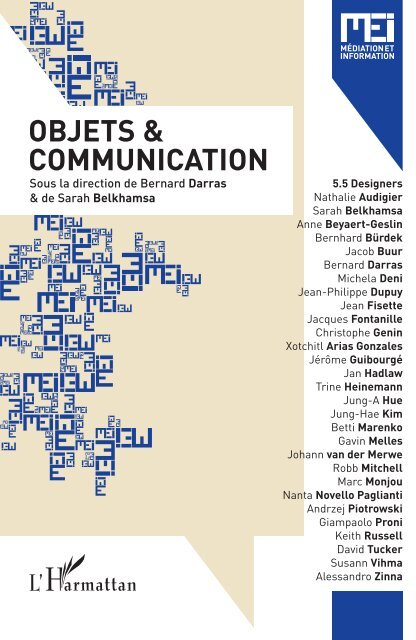
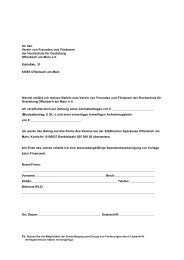
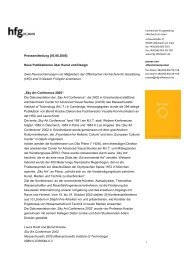
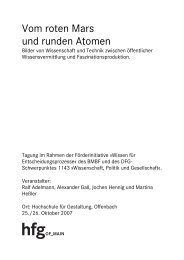
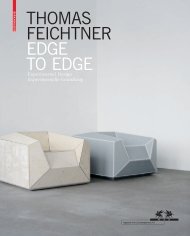
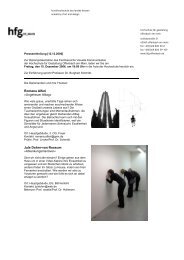

![Einladung [07.02.2006] - Hochschule für Gestaltung Offenbach am ...](https://img.yumpu.com/13375413/1/184x260/einladung-07022006-hochschule-fur-gestaltung-offenbach-am-.jpg?quality=85)
